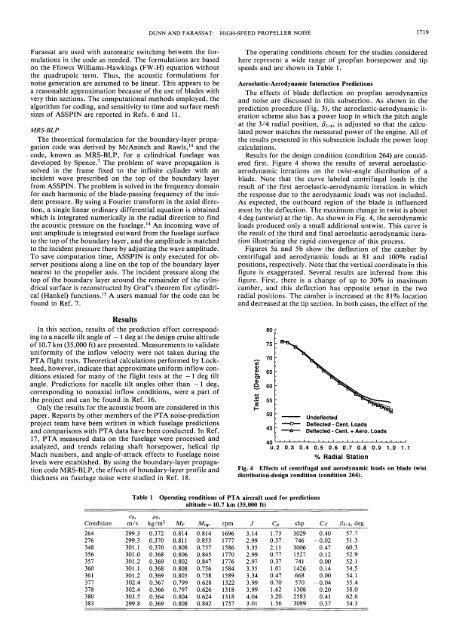High-Speed Propeller Noise Prediction—A ... - CAFE Foundation
High-Speed Propeller Noise Prediction—A ... - CAFE Foundation
High-Speed Propeller Noise Prediction—A ... - CAFE Foundation
You also want an ePaper? Increase the reach of your titles
YUMPU automatically turns print PDFs into web optimized ePapers that Google loves.
onthethe acoustica reasonabletothetopofthe boundaryPTA flightthe projectThe theoretical(35,000codeinflowderivedusingboundary-layerRawls,takenRef.the resultrapidshows% RadialinferredDUNN AND FARASSAT: HIGH-SPEED PROPELLER NOISE 1719Farassat are used with automatic switching between the formulationsinthe as needed. The formulations are basedFfowcs Williams-Hawkings (FW-H) equation withoutthe quadrupole term. Thus, the acoustic formulations fornoise generation are assumed to be linear. This appears to beapproximation because oftheuseof blades withvery thin sections. The computational methods employed, thealgorithm for coding, and sensitivity to time and surface meshsizes of ASSPIN are reported in Refs. 6and 11.MRS-BLPformulation forthe boundary-layer propagationcode was by McAninch 14andtheandcode, known as MRS-BLP, for a cylindrical fuselage wasdeveloped by Spence. problem 7The of wave propagation issolved in the frame fixed to the infinite cylinder with anincident wave prescribed on the top of the boundary layerfrom ASSPIN. The problem is solved in the frequency domainfor each harmonic of the blade-passing frequency of the incidentpressure. By using a Fourier transform inthe axial direction,a single linear ordinary differential equation is obtainedwhich is integrated numerically in the radial direction to findpressure onthe fuselage. incoming wave 14An ofunit amplitude is integrated outward from the fuselage surfacelayer, andthe amplitude is matchedto the incident pressure there by adjusting the wave amplitude.To save computation time, ASSPIN is only executed for observerpositions along a line on the top of the boundary layernearest tothe propeller axis. The incident pressure along thetop of the boundary layer around the remainder of the cylindricalsurface is reconstructed by Graf's theorem for cylindrical(Hankel) functions. 15 A users manual for the code can befound in Ref. 7.ResultsIn this section, results ofthe prediction effort correspondingtoa nacelle tilt angle of-1degathedesign cruise altitudeof 10.7 km ft)are presented. Measurements to validateuniformity ofthe velocity were not during thetests. Theoretical calculations performed by Lockheed,however, indicate that approximate uniform inflow conditionsexisted for many ofthe flight tests athe-1deg tiltangle. Predictions for nacelle tilt angles other than - 1 deg,corresponding to nonaxial inflow conditions, were a part ofandcanbe found in Ref. 16.Only the results for the acoustic boom are considered in thispaper. Reports by other members of the PTA noise-predictionproject team have been written in which fuselage predictionsand comparisons with PTA data have been conducted. In Ref.17, PTA measured data onthe fuselage were processed andanalyzed, and trends relating shaft horsepower, helical tipMach numbers, and angle-of-attack effects to fuselage noiselevels were established. By the boundary-layer propagationcode MRS-BLP, the effects of profile andthickness on fuselage noise were studied in 18.The operating conditions chosen for the studies consideredhere represent a wide range of propfan horsepower and tipspeeds and are shown in Table 1.Aeroelastic-Aerodynamic Interaction PredictionsThe effects of blade deflection on propfan aerodynamicsand noise are discussed in this subsection. As shown in theprediction procedure (Fig. 3), the aeroelastic-aerodynamic iterationscheme also hasa power loop in which the pitch angleat the 3/4 radial position, /3 3/4 , is adjusted so that the calculatedpower matches the measured power ofthe engine. Alofthe results presented in this subsection include the power loopcalculations.Results forthe design condition (condition 264) are consideredfirst. Figure 4 the results of several aeroelasticaerodynamiciterations on the twist-angle distribution of ablade. Note that the curve labeled centrifugal loads is theresult ofthe first aeroelastic-aerodynamic iteration in whichthe response due to the aerodynamic loads was not included.As expected, the outboard region ofthe blade is influencedmost by the deflection. The maximum change in twist is about4 deg (untwist) at the tip. As shown in Fig. 4, the aerodynamicloads produced only a small additional untwist. This curve isofthe third and final aeroelastic-aerodynamic iterationillustrating the convergence of this process.Figures 5a and 5b show the deflection of the camber bycentrifugal and aerodynamic loads at 81 and 100% radialpositions, respectively. Note that the vertical coordinate in thisfigure is exaggerated. Several results are from thisfigure. First, there is a change of up to 30% in maximumcamber, and this deflection has opposite sense in the tworadial positions. The camber is increased at the 81% locationand decreased at the tip section. In both cases, the effect of theO)0)Q8075706560555045UndeflectedDeflected - Cent. LoadsDeflected - Cent. + Aero. Loads40U.2 0.3 0.4 0.5 0.6 0.7 0.8 0.9 1.0 1.1StationFig. 4 Effects of centrifugal and aerodynamic loads on blade twistdistribution-design condition (condition 264).Table 1 Operatingconditions ofPTA aircraftused for predictionsaltitude = 10.7 km (35,000 ft)Condition264276348356357360361377378380383CO,m/s299.3299.3301.1301.0301.2301.1301.2302.4302.4303.5299.8PO,kg/m 30.3720.3700.3700.3680.3690.3680.3690.3670.3660.3640.369M F0.8140.8110.8080.8060.8020.8080.8050.7990.7970.8040.808Mip0.8140.8530.7570.8450.8470.7560.7580.6280.6260.6240.842rpm16961777158617701776158415891322131813181757J3.142.993.352.992.973.353.343.993.994.043.01C P1.730.372.110.770.371.010.470.701.623.201.56shp3029746300615277411426668570130825833089C T0.40-0.020.470.120.000.140.00-0.040.200.410.37183/4, deg57.751.360.352.952.154.554.155.458.062.654.3
















